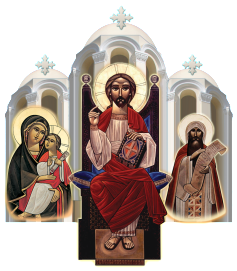Martyrdom of St. Mark
Founder of the Church of Alexandria
Pashons 1, 1741 – May 8, 2025
St. Mark was born in the city of Cyrene in Pentapolis, the western part of Libya. He was born of Jewish parents–Aristopoulos and Mary. His parents taught him in Greek and Hebrew, and he studied the Old Testament since he was young. His family lived in Cyrene until they were attacked by some barbarians. They lost their property because of the attacks, so they immigrated to Jerusalem.
St. Mark’s family was religious; his cousin was St. Barnabas, his father’s cousin was St. Peter’s wife, and his mother played an important part in the early days of the Church in Jerusalem. Furthermore, Christ instituted the Eucharist in St. Mark’s house (in the Upper Room). Mark was always associated with the Lord, so it is no surprise that he was one of the 70 Apostles who received the Holy Spirit on Pentecost.
One day, Aristopolus and his son Mark were walking near the Jordan River when they encountered a lion and lioness. Aristopolus thought that they would both be killed. Nonetheless, Mark prayed and assured his father that Jesus Christ would save them. The Lord heard his prayer and the two beasts died. As a result of this miracle, the father believed in Christ and was baptized by St. Mark.
St. Mark accompanied St. Peter on his missionary journeys in Jerusalem and Judea. He then accompanied Saints Paul and Barnabas preached the Gospel in Antioch, Selucia, Cyprus, Salamis, and Perga Pamphylia. However, for some reason St. Mark left them and returned home (Acts 13). On the next trip, St. Paul refused to take St. Mark with him because he left them on the first trip, so St. Barnabas then traveled with St. Mark to Cyprus (Acts 15).
After the departure of St. Barnabas in Cyprus, St. Mark went to Africa. He first traveled to Pentapolis, where he preached and performed miracles. He then entered Alexandria in 61 A.D. On his arrival, the strap of his sandal was loose, so he went to a cobbler named Anianus to fix it. While Anianus was repairing St. Mark’s shoe, an awl (small-pointed tool) pierced his finger. Anianus cried out saying, “O One God”. Hearing Anianus talk about one God astonished St. Mark, and he miraculously healed his wound. Afterwards, St. Mark started talking to Anianus about our Lord Jesus Christ and His sacrifice for mankind. This is when Anianus accepted the faith and invited St. Mark to his house. St. Mark then baptized St. Anianus’s family as they believed in Christ.
St. Mark established a theological school in Alexandria and a system for the Divine Liturgy known today as the Divine Liturgy of St. Cyril. He also wrote about the ministry of Christ in the Gospel of St. Mark. As the Christian faith grew and prospered in Egypt, and St. Mark then ordained Anianus as a bishop, three priests, and seven deacons to look after the congregation.
St. Mark left Alexandria and went to Rome to meet with St. Peter and St. Paul, and he stayed with them until their martyrdom in 64 A.D. Upon returning to Alexandria in 65 A.D., St. Mark found his people firm in faith and visited Pentapolis, where he spent two years preaching and performing miracles, adding more to the faith. He then finally returned to Alexandria where he was overjoyed to find that Christians had multiplied so much that they built a huge church in the suburban district of Bokalia.
In the year of 68 A.D., Easter fell on the same day as the feast of a pagan god, Syrabis. A mob of heathens gathered in the Syrabis temple at Alexandria and then attacked the Church filled with Christians celebrating the glorious Feast of Resurrection at Bokalia. St. Mark was seized and dragged with a rope through the main streets of the city. They continued dragging him with cruelty and his flesh was torn and scattered and the ground of the city was covered with his blood. They then cast him into a dark prison. The angel of the Lord then appeared to him and told him, “O Mark, the good servant, rejoice for your name has been written in the Book of Life, and you have been counted among the congregation of the saints.” The Lord then appeared to Mark and gave him peace and Mark’s soul rejoiced and was glad.
The following morning the pagans took St. Mark and tied his neck like they did before and dragged him amongst the stones. St. Mark then delivered up his pure soul and received the crown of Martyrdom. His flesh was torn, and it was the pagan’s intention to cremate his remains, but a severe storm blew and heavy rains fell and the pagans became scared and fled in fear. Christians stole his body and secretly buried him in a grave that they had engraved on a rock under the altar of the Church.
May the blessings of St. Mark be with us all.
Further Reading:

